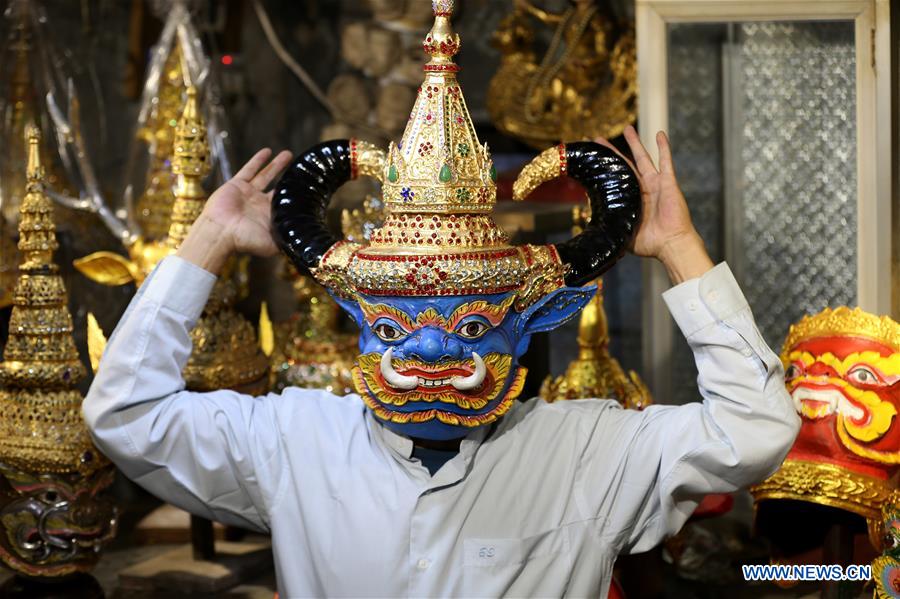
Sayar Sein wears a mask he made in Yangon, Myanmar, Dec. 5, 2019. For over a decade, Sayar Sein, a local Myanmar artisan, has been creating masks for the characters of Myanmar-version of Ramayana, an ancient Sanskrit tale. (Xinhua/U Aung)
YANGON, Dec. 18 (Xinhua) -- For over a decade, Sayar Sein, a local Myanmar artisan, has been creating masks for the characters of Myanmar-version of Ramayana, an ancient Sanskrit tale.
Originated from Hindu culture, the Ramayana tale has been adapted in many versions in Southeast Asian countries and the arrival of the tale in Myanmar dates back to King Anawrahta's reign by oral tradition and was named as Yama Zatdaw, later unofficially became the national epic.
The folk tale narrates a story of a prince named Rama of the Kosala Kingdom -- his travel life across India, along with his wife Sita and brother Lakshmana, as well as his quest to rescue his wife who was kidnapped by Ravana, a demon king.
Usually performing as a drama in the country's theaters, the characters -- Rama, Lakshmana, Sita, Ravana and Hanuman are mostly known to the public in Myanmar.
Sayar Sein has been fond of ogre mask since the age of 14 when he first found ogre and demon masks owned by Obo Nandwin Yama dance troupe, on the way to school.
He then started working with his master U Ohn Maung, head of the dance troupe, by helping his master in repairing masks used by the dance troupes.
"I've never dreamt of making the masks which I loved watching on the stage during my childhood days," Sayar Sein told Xinhua.
"There is a story behind each and every character of the Ramayana and my master not only taught me the know-hows of craftsmanship but also the detailed story of the character. Since then, I have done masks for almost every characters of the tale," said Sayar Sein who is now running his own art business including crafting masks for dramas, plays and religious festivals.
Of the characters in Yama Zatdaw, the craftsman loves to make the mask of Ravana, the 10-headed demon king. "The Ravana mask is my favorite one as the detailedness of the handwork and skills can be seen on its mask such as harmoniously assembling of its 10 heads," he said.
It takes about a month to make one mask from raw material to the final product on stage, and all the masks are mainly handcrafted by Sayar Sein alone.
The masks are made of papier-mache, latex for moulding process of facial features, and watercolor is mainly used for painting the masks while adding ornaments to the masks as the finishing touch.
"We need to adjust the painting colors of the masks with the lighting of the stage where the dramatic art will be performed using the masks," he said.
"The lifetime of a mask lasts long as much as we can maintain or preserve. My oldest creation is an ogre mask which was made in 1980," he added.
The artisan in his 60s has now another wish. "I am planning to open a gallery next year, where I can display all my masks for art-lovers and younger generations who are interested in making masks."
Prices of the masks made by Sayar Sein range from at least 150,000 kyats (100 U.S. dollars) to over 800,000 kyats (over 533 U.S. dollars).
"I mostly ask him to make ogre masks and religious masks for me as the masks he makes have perfect ratios due to his detailedness. The oldest one I bought from him dated back to 20 years ago. I don't think there is someone who is more skillful than him," Mhaw Satt Shin, one of his clients, told Xinhua.
Like other countries, the Yama Zatdaw or Ramayana may be derived from the same origin, but there are differences in making character masks based on the traditions of the countries. "That is why I want everyone to know that the Myanmar culture and traditions can be learnt through my masks," said Sayar Sein.